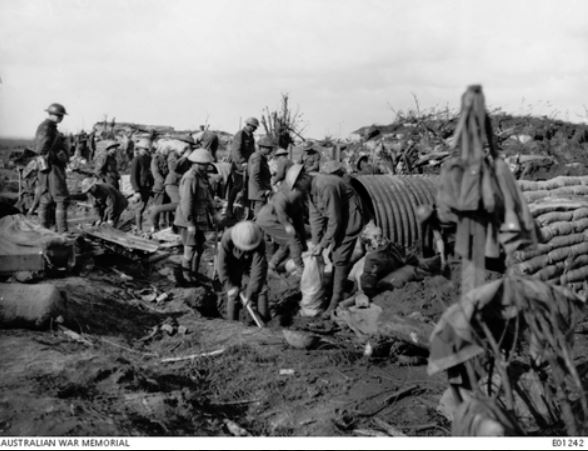Difference between revisions of "13th Field Company - Engineers"
From Our Contribution
(Created page with "{{Infobox | name = 13th Field Company | title = | above = | subheader = | image = File:4th_Field_Coy_Engineers.jpg | caption...") |
(→Unit Personnel) |
||
| Line 24: | Line 24: | ||
===Unit Personnel=== | ===Unit Personnel=== | ||
| − | * [[]] | + | * [[James Henry Larkin]] 6 Mar 1916 - 28 Feb 1917 |
| − | |||
==Battle Honours 13th Brigade== | ==Battle Honours 13th Brigade== | ||
Revision as of 00:40, 9 March 2021
 | |
 Engineers preparing overhead protection for a headquarters | |
Contents
Brief History
The 13th Field Company was raised to serve the 13th Brigade, 4th Division AIF in Tel-el-Kebir, Egypt and following training went on to serve on the Western Front.
Engineers, also known as sappers, were essential to the running of the war. Without them, other branches of the Allied Forces would have found it difficult to cross the muddy and shell-ravaged ground of the Western Front. Their responsibilities included constructing the lines of defence, temporary bridges, tunnels and trenches, observation posts, roads, railways, communication lines, buildings of all kinds, showers and bathing facilities, and other material and mechanical solutions to the problems associated with fighting in all theatres.
The 13th Field Company was raised in Egypt as part of the expansion of the AIF to provide engineering services to the 13th Brigade. After undertaking a period of training, the 13th Field Company sailed from Alexandria for France aboard HMT Missouri on 6 Jun 1916. Upon landing in Marseilles, it was transported north by rail. As part of the 13th Brigade it entered the front line for the first time near Petillon, in France.
For the next two-and-a-half years, the 13th Brigade took part in the fighting in the trenches along the Western Front in France and Belgium and was engaged in a number of significant actions. Its first major action came at Mouquet Farm in August 1916, which was followed by further actions at Messines and Passchendaele during 1917, and around Dernancourt, on the River Ancre, where the brigade fought a defensive action in early 1918.
The brigade's most notable action came during the Allied attack on Villers-Bretonneux on 25 April 1918, during the Second Battle of the Somme. The brigade's casualties during the offensive were heavy. After the German offensive was blunted, the remaining three battalions of the brigade undertook further actions as the Allies went on the offensive, launching their Hundred Days Offensive around Amiens in August. They continued operations into late September, attacking the Hindenburg Line. Early the following month, the majority of the Australian Corps brigade was withdrawn from the line for rest.
Unit Personnel
- James Henry Larkin 6 Mar 1916 - 28 Feb 1917
Battle Honours 13th Brigade
- Defence of Egypt
- Mouquet Farm
- Messines
- Passchendaele
- Villers Bretonneux
- Dernancourt
- Amiens
- Peronne
- Hindenburg Line
Individual Honours
Notes
Content for the history and honours sections has come from a combination of Wikipedia and the Australian War Memorial websites.